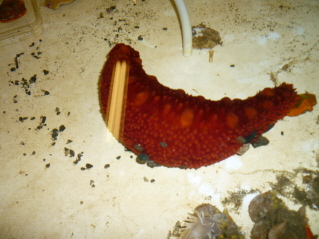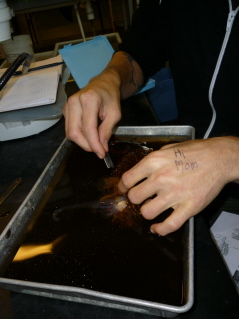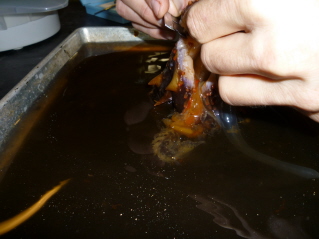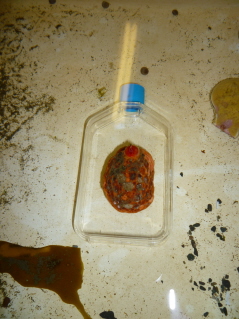Question: What is worm-like in flexibility, orange and textured, and feeds off deposits on the bottom of the sea floor?
Echinodermata – Parastichopus californicus is exactly that… and more!
In our dissection of this unfortunate sea cucumber Ross and I were able to explore the surprisingly simple inner workings of the sea cucumber. And by simple I mean the few parts that make this a living organism, not that the parts themselves are simple. What seemed like forever to sedate the poor creature in both mag-chloride and clove oil we finally just had to go for it and cut into it. We started at the mouth, which we learned may not have been the best approach, but how were we to know? Shortly after cutting into the cucumber the poor Parastichopus attempted its defense mechanism and eviscerated its guts for us to see. Most sea cucumbers can regenerate the internal organs that they expel, however we had other plans for this invert and proceeded to explore its internal workings.
Our sample consisted of Buccal tentacles, tentacular ampulla, a calareous ring, polian vesicle, esophagus, intestine, hemal plexus, and respiratory tree, with podium covering the outside. The only thing we were missing was the Gonads. Where were they? Was the cucumber not of maturity, are they only seasonal I wondered? My knowledge of marine inverts has yet to be expanded until this point. As it turns out, Parastichopus eviscerates its gut contents between October and November every year and regenerates new ones. Spawning takes place in late summer, Parastichopus is a broadcast spawner. Sill, why no gonads in this specimen? I’ve found out through this process of gonad research that they have a closed circulatory system and hemoglobin, but no heart, water internal vascular system, and a calcite internal skeleton. They also have a 5 banded mussel wall structure that makes them part of the Echinodermata phylum like sea-stars and urchins, this is called pentaradial symmetry. They can reach up to 50 cm but typically are only around 24 cm -40 cm, are gonochoristic, and they can live up to 8 years if they are lucky enough to escape commercial harvesting. Sushi anyone? I also saw a recipe for sea cucumber chowder… yum? Apparently there is a huge market for sea cumber. I still haven’t found out about those gonads… Ah ha! The California department of fish and game has some information for me. They say that when the Parastichopus undergoes its seasonal visceral atrophy the gonads, circulatory system and respiratory tree are reabsorbed and shrink during the process of gut degeneration. They say that juveniles also undergo this process, but have not yet developed gonads. Could this be a victory? I have now 2 hypotheses as to why we didn’t see gonads in our Parastichopus, 1) it was a juvenile and hadn’t developed gonads yet (this one seemed adult due to its size though) and 2) it was undergoing seasonal visceral atrophy and the gonads were not visible to us, (yet other organs were visible).
An interesting little factoid that I stumbled upon while doing research on the gonads was that sea cucumbers have dial and seasonal cycles of movement and metabolic activity. This made me think of the Nucella experiment and their tidal cycle. Correlation? We’ll have to find out!
That’s it for now!
Liza






